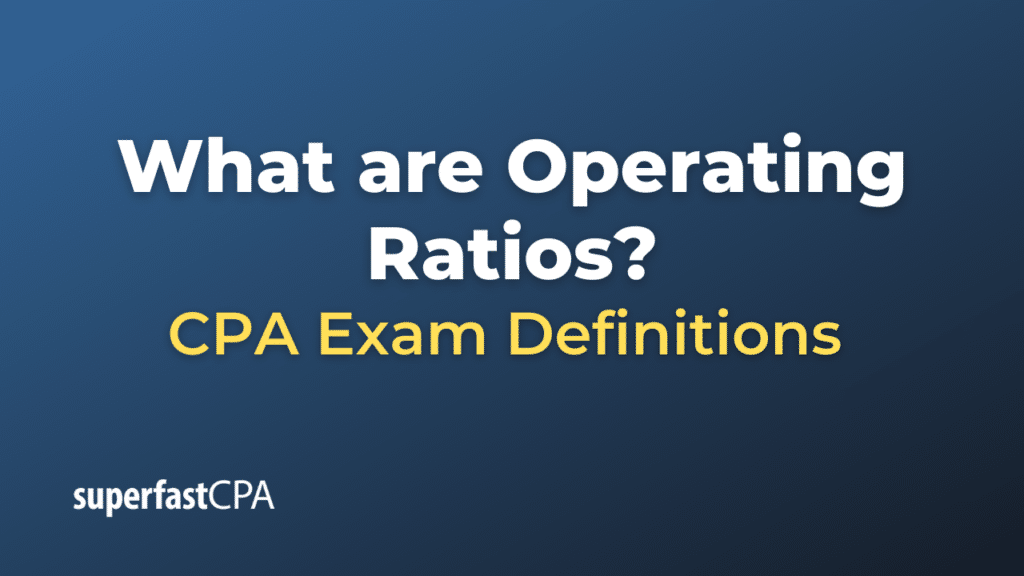Operating Ratios
Operating Ratios are a category of financial ratios that are used to measure a company’s operating efficiency and performance. These ratios are especially important for managers, investors, and creditors as they provide insights into the company’s operational management and its ability to generate profit.
Common operating ratios include:
- Operating Margin Ratio: This ratio measures how much profit a company makes on a dollar of sales, after paying for variable costs of production, but before paying interest or tax. It’s calculated as (Operating Income / Revenue) * 100%.
- Operating Expense Ratio: This ratio compares the total operating expenses of a company to the net sales to understand how much proportion of revenue is used towards covering the operating expenses. The formula is (Operating Expenses / Net Sales) * 100%.
- Gross Margin Ratio: Also known as the Gross Profit Margin, it measures the proportion of money left over from revenues after accounting for the cost of goods sold. Gross margin ratio is calculated as (Gross Profit / Revenue) * 100%.
- Inventory Turnover Ratio: This ratio shows how many times a company’s inventory is sold and replaced over a given period. It’s calculated as Cost of Goods Sold / Average Inventory.
- Accounts Receivable Turnover Ratio: This measures how effectively a company extends credit and collects debts on that credit. The ratio is calculated as Net Credit Sales / Average Accounts Receivable.
- Asset Turnover Ratio: This ratio measures a company’s ability to generate sales from its assets by comparing net sales with total assets. The formula is Net Sales / Total Assets.
Operating ratios vary across industries, and therefore it’s always a good practice to compare these ratios with industry peers. Also, a trend analysis over time can provide valuable insights into whether a company’s operational efficiency is improving or deteriorating.
Example of Operating Ratios
Let’s take the hypothetical company, Example Corp., and calculate some operating ratios. Here are some simplified numbers for the fiscal year:
- Revenue: $1,000,000
- Cost of Goods Sold (COGS): $400,000
- Operating Expenses: $200,000
- Average Inventory: $50,000
- Net Credit Sales: $900,000
- Average Accounts Receivable: $100,000
- Total Assets: $2,000,000
Now, let’s calculate the ratios:
- Operating Margin Ratio:
Operating Income = Revenue – Operating Expenses = $1,000,000 – $200,000 = $800,000
Operating Margin Ratio = (Operating Income / Revenue) * 100% = ($800,000 / $1,000,000) * 100% = 80% - Operating Expense Ratio:
Operating Expense Ratio = (Operating Expenses / Revenue) * 100% = ($200,000 / $1,000,000) * 100% = 20% - Gross Margin Ratio:
Gross Profit = Revenue – COGS = $1,000,000 – $400,000 = $600,000
Gross Margin Ratio = (Gross Profit / Revenue) * 100% = ($600,000 / $1,000,000) * 100% = 60% - Inventory Turnover Ratio:
Inventory Turnover Ratio = COGS / Average Inventory = $400,000 / $50,000 = 8 times - Accounts Receivable Turnover Ratio:
Accounts Receivable Turnover Ratio = Net Credit Sales / Average Accounts Receivable = $900,000 / $100,000 = 9 times - Asset Turnover Ratio:
Asset Turnover Ratio = Revenue / Total Assets = $1,000,000 / $2,000,000 = 0.5 times
These ratios give us insights into the company’s operational efficiency and profitability. For instance, Example Corp. is retaining 80% of each dollar of revenue as operating income, and it’s selling and replacing its inventory 8 times a year.
However, keep in mind that these ratios need to be compared with industry standards or with ratios of other companies in the same industry to gain meaningful insights. The standalone figures don’t provide much information without a benchmark or trend analysis.













